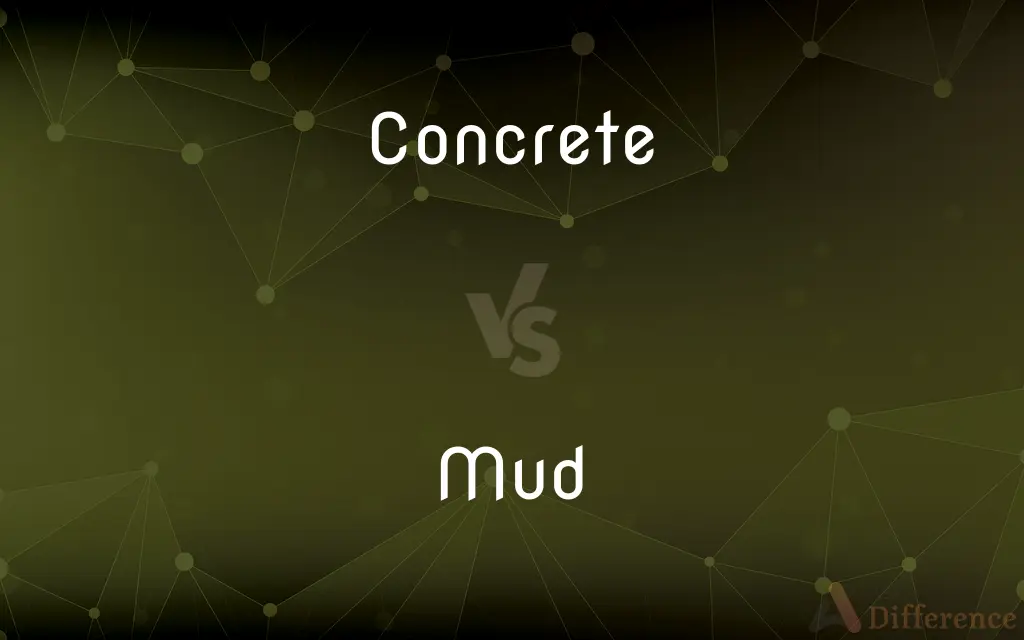Concrete vs. Mud — What's the Difference?
Edited by Tayyaba Rehman — By Urooj Arif — Updated on March 31, 2024
Concrete is a construction material, while mud is a natural mixture of water and soil.

Difference Between Concrete and Mud
Table of Contents
ADVERTISEMENT
Key Differences
Concrete is a widely used construction material, composed of cement, water, sand, and gravel, known for its strength and durability. It sets and hardens over time, offering significant structural support in buildings, roads, and bridges. On the other hand, mud is a natural mixture of water and soil, earth, or clay. It's malleable when wet, making it useful in certain types of construction, such as adobe bricks, but lacks the hardened strength and durability of concrete.
Concrete's composition can be precisely controlled, allowing for the adjustment of its properties to meet specific engineering requirements. This makes it versatile for various construction needs. Mud, in contrast, has variable properties depending on the soil or clay type and water content. While it's been used historically for construction, its applications are limited by its lower strength and durability compared to modern materials like concrete.
The process of making concrete involves mixing its components to achieve a homogenous blend that can be poured into forms to shape it as it hardens. Mud, however, is prepared simply by mixing soil or clay with water until the desired consistency is achieved. This simplicity makes mud an accessible material in many parts of the world, though its use is often restricted to less permanent structures or in combination with other materials for improved performance.
In terms of environmental impact, concrete production is energy-intensive and contributes significantly to CO2 emissions. Mud, being a natural material, has a lower environmental footprint, making it an attractive option for sustainable building practices. However, the longevity and maintenance requirements of mud structures can vary widely, often necessitating regular upkeep or protection against the elements to ensure durability.
Despite their differences, both concrete and mud have played crucial roles in construction throughout history. Concrete is favored in modern construction for its strength, longevity, and versatility, while mud remains valued in specific contexts for its natural availability, environmental benefits, and cultural significance in traditional building practices.
ADVERTISEMENT
Comparison Chart
Composition
Cement, water, sand, gravel.
Water and soil/clay.
Use in Construction
Extensive for structural support.
Limited, often for adobe bricks or traditional methods.
Properties
High strength and durability.
Variable strength; malleable when wet.
Production Process
Mixing components, then pouring and curing.
Simple mixing of soil/clay with water.
Environmental Impact
High CO2 emissions from production.
Lower environmental footprint.
Maintenance
Low maintenance; long-lasting.
Requires regular upkeep to maintain integrity.
Historical Use
Modern construction material.
Used historically and in traditional construction.
Compare with Definitions
Concrete
A building material made from a mixture of cement, water, sand, and gravel.
Concrete is used to construct foundations, bridges, and roads.
Mud
Primarily for traditional or sustainable building practices.
Mud houses are common in some rural and eco-friendly communities.
Concrete
Can be cast into various shapes and sizes.
Concrete is versatile enough to be used for both large skyscrapers and small residential sidewalks.
Mud
A natural mixture of water and soil or clay.
Mud is often used in making adobe bricks for building houses.
Concrete
Produces significant CO2 during production.
The cement industry is one of the largest producers of CO2.
Mud
Less durable than concrete; requires more maintenance.
Mud structures may need regular repairs to withstand weathering.
Concrete
Known for its high strength and longevity.
Concrete structures can last for hundreds of years with minimal maintenance.
Mud
Has a long history in human settlements and architecture.
Mud brick construction dates back thousands of years and is part of many cultural heritages.
Concrete
Became prevalent in modern construction for its durability.
The use of concrete revolutionized the construction industry in the 20th century.
Mud
Easily sourced and environmentally friendly.
Mud is a low-cost, natural building material that minimizes environmental impact.
Concrete
Concrete is a composite material composed of fine and coarse aggregate bonded together with a fluid cement (cement paste) that hardens (cures) over time. In the past, lime based cement binders, such as lime putty, were often used but sometimes with other hydraulic cements, such as a calcium aluminate cement or with Portland cement to form Portland cement concrete (named for its visual resemblance to Portland stone).
Mud
Mud is soil, loam, silt or clay mixed with water. It usually forms after rainfall or near water sources.
Concrete
Existing in a material or physical form; not abstract
Concrete objects like stones
Mud
A computer-based text or virtual reality game which several players play at the same time, interacting with each other as well as with characters controlled by the computer.
Concrete
A building material made from a mixture of broken stone or gravel, sand, cement, and water, which can be spread or poured into moulds and forms a mass resembling stone on hardening
Slabs of concrete
Concrete blocks
Mud
A computer program, usually running over the internet, that allows multiple users to participate in virtual-reality role-playing games.
Concrete
Cover (an area) with concrete
The precious English countryside may soon be concreted over
Mud
Wet, sticky, soft earth, as on the banks of a river.
Concrete
Form (something) into a mass; solidify
The juices of the plants are concreted upon the surface
Mud
(Slang) Wet plaster, mortar, or cement.
Concrete
Of or relating to an actual, specific thing or instance; particular
Had the concrete evidence needed to convict.
Mud
Slanderous or defamatory charges or comments
Slinging mud at his opponent.
Concrete
Relating to nouns, such as flower or rain, that denote a material or tangible object or phenomenon.
Mud
To cover or spatter with or as if with mud.
Concrete
Existing in reality or in real experience; perceptible by the senses; real
Concrete objects such as trees.
Mud
A mixture of water and soil or fine grained sediment.
Concrete
Formed by the coalescence of separate particles or parts into one mass; solid.
Mud
A plaster-like mixture used to texture or smooth drywall.
Concrete
Made of hard, strong, conglomerate construction material.
Mud
(construction industry slang) Wet concrete as it is being mixed, delivered and poured.
Concrete
A hard, strong construction material consisting of sand, conglomerate gravel, pebbles, broken stone, or slag in a mortar or cement matrix.
Mud
(figuratively) Willfully abusive, even slanderous remarks or claims, notably between political opponents.
The campaign issues got lost in all the mud from both parties.
Concrete
A mass formed by the coalescence of particles.
Mud
(slang) Money, dough, especially when proceeding from dirty business.
Concrete
To build, treat, or cover with hard, strong conglomerate construction material.
Mud
(geology) A particle less than 62.5 microns in diameter, following the Wentworth scale
Concrete
To form into a mass by coalescence or cohesion of particles or parts.
Mud
A black person.
Concrete
To harden; solidify.
Mud
Drilling fluid.
Concrete
Real, actual, tangible.
Fuzzy videotapes and distorted sound recordings are not concrete evidence that Bigfoot exists.
Once arrested, I realized that handcuffs are concrete, even if my concept of what is legal wasn’t.
Mud
(slang) Coffee.
Concrete
Being or applying to actual things, not abstract qualities or categories.
Mud
(transitive) To make muddy or dirty; to apply mud to (something).
Concrete
Particular, specific, rather than general.
While everyone else offered thoughts and prayers, she made a concrete proposal to help.
Concrete ideas
Mud
(transitive) To make turbid.
Concrete
United by coalescence of separate particles, or liquid, into one mass or solid.
Mud
(intransitive) To go under the mud, as an eel does.
Concrete
Made of concrete, a building material.
The office building had concrete flower boxes out front.
Mud
To participate in a MUD or multi-user dungeon.
Concrete
(obsolete) A solid mass formed by the coalescence of separate particles; a compound substance, a concretion.
Mud
Earth and water mixed so as to be soft and adhesive.
Concrete
Specifically, a building material created by mixing cement, water, and aggregate such as gravel and sand.
The road was made of concrete that had been poured in large slabs.
Mud
To bury in mud.
Concrete
(logic) A term designating both a quality and the subject in which it exists; a concrete term.
Mud
To make muddy or turbid.
Concrete
Sugar boiled down from cane juice to a solid mass.
Mud
Water soaked soil; soft wet earth
Concrete
(US) A dessert of frozen custard with various toppings.
Mud
Slanderous remarks or charges
Concrete
(chemistry) An extract of herbal materials that has a semi-solid consistency, especially when such materials are partly aromatic.
Mud
Soil with mud, muck, or mire;
The child mucked up his shirt while playing ball in the garden
Concrete
To cover with or encase in concrete (building material).
I hate grass, so I concreted over my lawn.
Mud
Plaster with mud
Concrete
To solidify: to change from being abstract to being concrete (actual, real).
Concrete
To unite or coalesce into a mass or a solid body.
Concrete
United in growth; hence, formed by coalition of separate particles into one mass; united in a solid form.
The first concrete state, or consistent surface, of the chaos must be of the same figure as the last liquid state.
Concrete
Standing for an object as it exists in nature, invested with all its qualities, as distinguished from standing for an attribute of an object; - opposed to abstract.
Concrete is opposed to abstract. The names of individuals are concrete, those of classes abstract.
Concrete terms, while they express the quality, do also express, or imply, or refer to, some subject to which it belongs.
Concrete
A compound or mass formed by concretion, spontaneous union, or coalescence of separate particles of matter in one body.
To divide all concretes, minerals and others, into the same number of distinct substances.
Concrete
A mixture of gravel, pebbles, or broken stone with cement or with tar, etc., used for sidewalks, roadways, foundations, etc., and esp. for submarine structures.
Concrete
A term designating both a quality and the subject in which it exists; a concrete term.
The concretes "father" and "son" have, or might have, the abstracts "paternity" and "filiety".
Concrete
Sugar boiled down from cane juice to a solid mass.
Concrete
To unite or coalesce, as separate particles, into a mass or solid body.
Concrete
To form into a mass, as by the cohesion or coalescence of separate particles.
There are in our inferior world divers bodies that are concreted out of others.
Concrete
To cover with, or form of, concrete, as a pavement.
Concrete
A strong hard building material composed of sand and gravel and cement and water
Concrete
Cover with cement;
Concrete the walls
Concrete
Form into a solid mass; coalesce
Concrete
Capable of being perceived by the senses; not abstract or imaginary;
Concrete objects such as trees
Concrete
Formed by the coalescence of particles
Common Curiosities
What is concrete?
Concrete is a man-made construction material composed of cement, water, sand, and gravel, known for its strength and durability.
What is mud?
Mud is a natural mixture of water and soil or clay, used in some building practices for its malleability and low environmental impact.
What are the environmental impacts of concrete vs. mud?
Concrete production is energy-intensive and a significant source of CO2 emissions, while mud has a lower environmental footprint.
How do concrete and mud differ in construction?
Concrete is used extensively in modern construction for structural support, while mud is limited to certain types of construction, often traditional or for sustainable practices.
Are there any advantages of using mud over concrete?
Mud offers environmental benefits, is low-cost, and has cultural significance in certain communities.
What maintenance does mud construction require?
Mud constructions often require regular upkeep, such as reapplying mud plaster, to maintain their structural integrity and weather resistance.
Can mud be as durable as concrete?
Generally, mud is less durable than concrete and requires more maintenance, though techniques like adobe can improve its longevity.
Can mud be used in all types of construction?
Mud is not suitable for all types of construction, especially where high strength and durability are required, but it is valuable in specific applications and climates.
How are concrete and mud prepared?
Concrete is made by mixing cement, water, sand, and gravel, then curing it. Mud is prepared by mixing water with soil or clay to the desired consistency.
How do concrete and mud contribute to sustainable building?
While mud is inherently sustainable, concrete's role in sustainable building focuses on improving its production process and recycling concrete materials.
Why is concrete preferred in modern construction?
Concrete's high strength, durability, and versatility make it preferred for modern construction needs.
Is concrete environmentally friendly?
While concrete has many benefits, its production is not environmentally friendly due to high CO2 emissions. However, efforts are underway to make it more sustainable.
How has the use of concrete evolved?
Concrete's use has evolved from basic structural applications to complex architectural designs, benefiting from technological advancements in material science.
What historical significance does mud hold in construction?
Mud has been a fundamental building material throughout human history, used in ancient civilizations and continuing in traditional construction practices today.
Can innovations in concrete reduce its environmental impact?
Yes, innovations such as alternative cements and recycling concrete waste are aimed at reducing the environmental impact of concrete production.
Share Your Discovery

Previous Comparison
Protentional vs. Potential
Next Comparison
Stats vs. StatusAuthor Spotlight
Written by
Urooj ArifUrooj is a skilled content writer at Ask Difference, known for her exceptional ability to simplify complex topics into engaging and informative content. With a passion for research and a flair for clear, concise writing, she consistently delivers articles that resonate with our diverse audience.
Edited by
Tayyaba RehmanTayyaba Rehman is a distinguished writer, currently serving as a primary contributor to askdifference.com. As a researcher in semantics and etymology, Tayyaba's passion for the complexity of languages and their distinctions has found a perfect home on the platform. Tayyaba delves into the intricacies of language, distinguishing between commonly confused words and phrases, thereby providing clarity for readers worldwide.














































